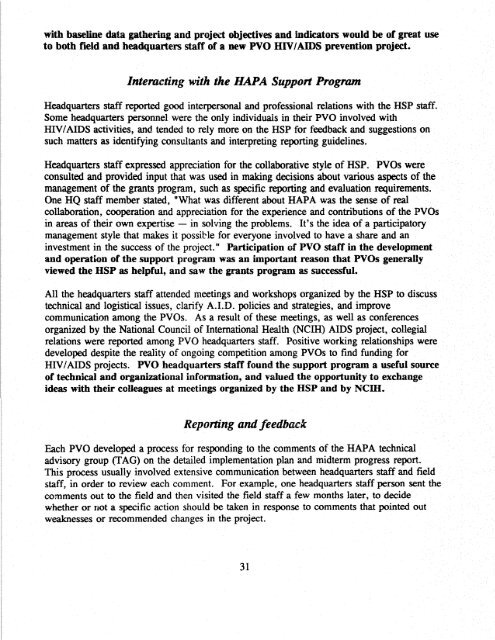The HAPA Support Program - usaid
The HAPA Support Program - usaid
The HAPA Support Program - usaid
You also want an ePaper? Increase the reach of your titles
YUMPU automatically turns print PDFs into web optimized ePapers that Google loves.
with baseline data gathering and projed objectives and indicators would be of great use<br />
to both field and headquarters staff of a new PVO DIYIAIDS prevention project.<br />
Interacting with the <strong>HAPA</strong> <strong>Support</strong> <strong>Program</strong><br />
Headquarters staff reported good interpersonal and professional relations with the HSP staff.<br />
Some headquarters personnel were the only individuals in their pya involved with<br />
mYIAIDS activities, and tended to rely more on the HSP for feedback and suggestions on<br />
such matters as identifying consultants and interpreting reporting guidelines.<br />
Headquarters staff expressed appreciation for the collaborative style of HSP. pyas were<br />
consulted and provided input that was used in making decisions about various aspects of the<br />
management of the grants program, such as specific reporting and evaluation requirements.<br />
One HQ staff member stated, "What was different about <strong>HAPA</strong> was the sense ofreal<br />
collaboration, cooperation and appreciation for the experience and contributions of the PYOs<br />
in areas of their own expertise - in solving the problems. It's the idea of a participatory<br />
management style that makes it possit-le for everyone involved to have a share and an<br />
investment in the success of the project." Participation of PVO staff in the development<br />
and operation of the support program was an important reason that PVOS generally<br />
viewed the HSP as helpful, and saw the grants program as successful.<br />
All the headquarters staff attended meetings and workshops organized by the HSP to discuss<br />
technical and logistical issues, clarify A.I.D. policies and strategies, and improve<br />
communication among the PYOs. As a result of these meetings, as well as conferences<br />
organized by the National Council of International Health (NCIH) AIDS project, collegial<br />
relations were reported among PVO headquarters staff. Positive working relationships were<br />
developed despite the reality of ongoing competition among PVOs to find funding for<br />
mvIAIDS projects. PVO headquarters staff found the support program a useful source<br />
of technical and organizational information, and valued the opportunity to exchange<br />
ideas with their colleagues at meetings organized by the HSP and by Nelli.<br />
Reporting and feedback<br />
Each pva developed a process for responding to the comments of the <strong>HAPA</strong> technical<br />
advisory group (TAG) on the detailed implementation plan and midterm progress report.<br />
This process usually involved extensive communication between headquarters staff and field<br />
staff, in order to review each comment. For example, one headquarters staff person sent the<br />
comments out to the field and then visited the field staff a few months later, to decide<br />
whether or not a specific action should be taken in response to comments that pointed out<br />
weaknesses or recommended changes in the project.<br />
31

















